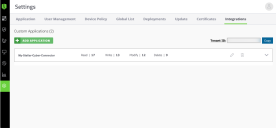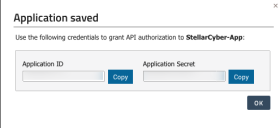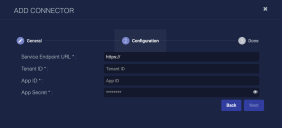Configuring BlackBerry Cylance Connectors
The BlackBerry Cylance connector allows you to lock down a device that is associated with an event reported by another connector. In Stellar Cyber, this connector is used for lock down only, not event tracking.
The devices you want to lock down using this connector must be configured using BlackBerry's CylancePROTECT Console to have a policy that permits device control (or to be in a zone configured with a policy that has device control enabled).
Connector Overview: Blackberry Cylance
Capabilities
-
Collect: No
-
Respond: Yes
-
Native Alerts Mapped: Yes
-
Runs on: DP
-
Interval: N/A
Collected Data
N/A
Domain
|
<Service Endpoint URL> where <Service Endpoint URL> is a variable from the configuration of this connector |
Response Actions
|
Action |
Required Fields |
|---|---|
|
|
|
|
Available on Request: The following response actions are available on request via the Universal Webhook Responder:
|
|
Third Party Native Alert Integration Details
For CylancePROTECT, three types of Cylance events are mapped to the XDR Kill Chain and Stellar Cyber's Alert index: Exploit Attempts, Script Control, and Threats. The other data (Audit Log, Device, Device Control, and Threat Classification) are ingested and mapped to the Syslog index (not Alerts index), and are not run through the ML/SA pipeline.
For CylanceOPTICS, Detection events are evaluated with Stellar Cyber time series analysis models to determine abnormality of the event before mapping.
For details, see Integration of Third Party Native Alerts.
Required Credentials
-
Service Endpoint URL, Tenant ID, App ID, and App Secret
Locating Records
Use the following to query for records:
-
msg_origin.source:
cylance_protectorcylance_optics -
msg_class:
cylance_protect_alertorcylance_optics_event
Let us know if you find the above overview useful.
Adding a Blackberry Cylance Connector
To add a Blackberry Cylance connector:
- Set up Stellar Cyber in CylancePROTECT and obtain IDs
- Add the connector in Stellar Cyber
- Test the Connector
- Use the Connector
Use our example as a guideline, as you might be using a different software version.
Setting up the Stellar Cyber App Integration
-
Log in to the CylancePROTECT Console as an administrator.
-
Select Settings > Integrations.
-
Click Add Application.
-
Type an Application Name. This must be unique within your organization.
-
Select the access privileges for a Console data type. Not selecting any checkboxes for a data type means the application does not have access to that data type.
-
Click Save.
-
The credentials to use for the application displays. Make note of both the Application ID and the Application Secret.
-
Click OK to return to the Integrations tab.
-
Note that your new application appears in the list. At this point, make note of the Tenant ID that is displayed on the Integrations tab.
The syntax of the Tenant ID must be exactly as it appears here.
You are now ready to set up your Stellar Cyber Cylance connector.
Adding the Connector in Stellar Cyber
After you have noted the configuration information, you can add the BlackBerry Cylance connector in Stellar Cyber:
-
Log in to Stellar Cyber.
-
Click System | Integration | Connectors. The Connector Overview appears.
-
Click Create. The General tab of the Add Connector screen appears. The information on this tab cannot be changed after you add the connector.
The asterisk (*) indicates a required field.
-
Choose Endpoint Security from the Category drop-down.
-
Choose Blackberry Cylance from the Type drop-down.
-
For this connector, the supported Function is Respond, which is enabled already.
-
Enter a Name.
Notes:- This field does not accept multibyte characters.
- It is recommended that you follow a naming convention such as tenantname-connectortype.
-
Choose a Tenant Name. The Interflow records created by this connector include this tenant name.
-
Choose the device on which to run the connector.
-
Click Next. The Configuration tab appears.
The asterisk (*) indicates a required field.
-
Enter the Service Endpoint URL (URL of your regional BlackBerry Cylance portal). Do not append any details to this URL, just the value indicated below for your region:
Region
URL
Asia-Pacific - North
https://protectapi-apne1.cylance.com/
Asia-Pacific - Southeast
https://protectapi-au.cylance.com/
Europe - Central
https://protectapi-euc1.cylance.com/
North America
https://protectapi.cylance.com/
South America
https://protectapi-sae1.cylance.com/
US Government
https://protectapi.us.cylance.com/
For release versions prior to v4.3.4, ensure the URL does not include a trailing "/" symbol.
-
Enter the Tenant ID you noted earlier.
The syntax of the Tenant ID must be exactly as it appeared in the Integration tab of the Cylance Console.
-
Enter the App ID you noted earlier.
-
Enter the App Secret you noted earlier
-
Click Next. The final confirmation tab appears.
-
Click Submit.
The new connector is immediately active.
Testing the Connector
When you add (or edit) a connector, we recommend that you run a test to validate the connectivity parameters you entered. (The test validates only the authentication / connectivity; it does not validate data flow).
For connectors running on a sensor, Stellar Cyber recommends that you allow 30-60 seconds for new or modified configuration details to be propagated to the sensor before performing a test.
-
Click System | Integrations | Connectors. The Connector Overview appears.
-
Locate the connector that you added, or modified, or that you want to test.
-
Click Test at the right side of that row. The test runs immediately.
Note that you may run only one test at a time.
Stellar Cyber conducts a basic connectivity test for the connector and reports a success or failure result. A successful test indicates that you entered all of the connector information correctly.
To aid troubleshooting your connector, the dialog remains open until you explicitly close it by using the X button. If the test fails, you can select the button from the same row to review and correct issues.
The connector status is updated every five (5) minutes. A successful test clears the connector status, but if issues persist, the status reverts to failed after a minute.
Repeat the test as needed.
If the test fails, the common HTTP status error codes are as follows:
| HTTP Error Code | HTTP Standard Error Name | Explanation | Recommendation |
|---|---|---|---|
| 400 | Bad Request | This error occurs when there is an error in the connector configuration. |
Did you configure the connector correctly? |
| 401 | Unauthorized |
This error occurs when an authentication credential is invalid or when a user does not have sufficient privileges to access a specific API. |
Did you enter your credentials correctly? Are your credentials expired? Are your credentials entitled or licensed for that specific resource? |
| 403 | Forbidden | This error occurs when the permission or scope is not correct in a valid credential. |
Did you enter your credentials correctly? Do you have the required role or permissions for that credential? |
| 404 | Not Found | This error occurs when a URL path does not resolve to an entity. | Did you enter your API URL correctly? |
| 429 | Too Many Requests |
This error occurs when the API server receives too much traffic or if a user’s license or entitlement quota is exceeded. |
The server or user license/quota will eventually recover. The connector will periodically retry the query. If this occurs unexpectedly or too often, work with your API provider to investigate the server limits, user licensing, or quotas. |
For a full list of codes, refer to HTTP response status codes.
Using the Connector to Contain a Host
When an event has occurred on a host known to the BlackBerry Cylance connector, you can use this to isolate the associated host. From the Event list in Investigate | Threat Hunting, you can select the event of interest, then click More Info. From there, you can select External Action | Endpoint | Contain Host. In the displayed Contain Host Action Configuration block, select the relevant connector and in the Target, specify the source or destination host to lock down.
For more information on working with the events and the actions on them, refer to Understanding Event Details.











